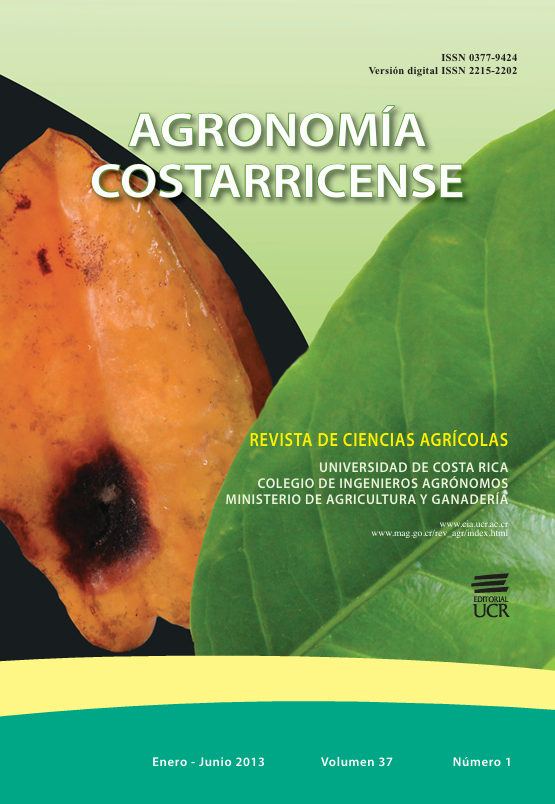Abstract
Sansevieria spp. (Agavaceae), native to Africa and Asia, is a foliage ornamental known as “mother-in-law’s tongue” or sansevieria. S. trifasciata (St) is the species with the highest number of cultivars on the Costa Rican export market. (to the United States and the Netherlands). Leaf samples of S. trifasciata var. “Hahnii” with circular and aqueous lesions, (some dried and elongated) were analyzed. From infected tissue five monohyphal isolates were obtained. The pathogen was identified as Colletotrichum sansevieriae Nakamura (CsN) on the basis of pathogenicity tests, morphology and molecular techniques. Colonies were creamcolored, flat and produced few conidia. The pathogenicity of the isolates was assessed on 7 varieties of St; Sansevieria sp., var. Jiboia; S. cylindrica and the ornamentals Codiaeum variegatum, Cordelyne terminalis and Dracaena deremensis through greenhouse (pot) and laboratory (separate leaves) inoculations. In both conditions disease symptoms were reproduced. Five of the S. trifasciata varieties evaluated developed symptoms, var. “Hahnii” the most susceptible. The same pathogen was reisolated from inoculated leaves (Koch’s postulates). PCR amplification of the ITS region with starters ITS5 and ITS4 yielded a single fragment of approximately 600 base pairs. Sequences of the ITS regions of isolates were identical. Sequences exhibited 99-100% nucleotide identity to isolates of CsN collected from diseased sansevieria in Australia and USA. Phylogenetic analysis, based on ITS2 region, indicates that the Costa Rican isolates clustered (99% bootstrap support) with the type species CsN from Japan and Australia and USA isolates. To our knowledge, this is the first report of CsN causing anthracnose of sansevieria in C.R.References
AGRIOS G.N. 2005. Plant pathology. 5th. Ed. Elsevier Acad. Press. Burlington. Mass, EU. 251-262 p.
ALDAOUD R., DEALWIS S., SALIB S., CUNNINGTON J.H., DOUGHTY S. 2011. First record of Colletotrichum sansevieriae on Sansevieria sp., (mother-in-law’s tongue) in Australia. Australasian Plant Dis. Notes 6(1):60-61.
ALTSCHUL S.F., MADDEN T.L., SCHÄFFER A.A., ZHANG J., ZHANG Z., MILLER W., LIPMAN D.J. 1997. Gapped BLAST and PSI-BLAST: a new generation of protein database search programs. Nucleic Acids Res. (25):3389-3402.
HALL T.A. 1999. BioEdit: a user-friendly biological sequence alignment editor and analysis program for Windows 95/98/NT. Nucleic Acids Symposium Series 41:95–98.
HYDE K.D., CAI L., MCKENZIE E.H.C., YANG Y.L., ZHANG J.Z., PRIHASTUTI H. 2009. Colletotrichum: a catalogue of confusion. Fungal Diversity 39:1-17.
KHALUMBA M.L., MBUGUA P.K., KUNG’U J.B. 2005. Uses and conservation of some highland species of the genus Sansevieria. African Crop Science Conference Proceedings. Vol. 7:527-532.
MINISTERIO DE AGRICULTURA Y GANADERÍA (MAG). 2007. Agencia de servicios agropecuarios La Tigra. Informe Censo de Plantas Ornamentales, Región Huetar Norte. Costa Rica (en línea). Consultado el 13 marzo 2011. Disponible en http://www.mag.go.cr/bibliotecavirtual/a00004.pdf
MORA F. 2008. Plan de gestión para la caracterización de la producción primaria del principal ornamental en la región Huétar Norte de Costa Rica. Tesis de maestría en Administración de Proyectos. Universidad para la Cooperación Internacional, Costa Rica. 154 p.
NAKAMURA M., OHZONO M., IWAI H., ARAI K. 2006. Anthracnose of Sansevieria trifasciata caused by Colletotrichum sansevieriae sp., nov. J. Gen Plant Pathol 72:253–256.
PALMATEER A.J., TARNOWSKI T.L.B., LÓPEZ P. 2012. First Report of Colletotrichum sansevieriae Causing Anthracnose of Sansevieria trifasciata in Florida. Plant Disease 96(2):293.
PERES N.A., TIMMER L.W., ADASKAVEG J.E., CORRELL J.C. 2005. Life styles of Colletotrichum acutatum. Plant Disease 89(8):784-796.
PROMOTORA DEL COMERCIO EXTERIOR DE COSTA RICA (PROCOMER). 2010. Estadísticas de Comercio Exterior Costa Rica, 2000. GRUPO NACIÓN. San José, Costa Rica. 240 p.
ROGERS S.O., BENDICH A.J. 1988. Extraction of DNA from plant tissues, pp. A6: l-10. In: S.B Gelvin, R.A Schilperoort (eds.). Plant Molecular Biology Manual. Boston, MA: Kluwer Academic Publisher.
SÁNCHEZ DE LORENZO CÁCERES J.M. 2006. Las especies del género Sansevieria cultivadas en España (en línea). Consultado en 9 de marzo, 2012. Disponible en http://www.arbolesornamentales.es/Sansevieria.htm
SANGEETHA S.G., RAWAL R.D. 2010. Temperature requirement of different isolates of Colletotrichum gloeosporioides isolated from mango. African Journal of Biotechnology 9(21):3086-3090.
SREENIVASAPRASAD S., TALHINHAS P. 2005. Genotypic and phenotypic diversity in Colletotrichum acutatum a cosmopolitan pathogen causing anthracnose on a wide range of hosts. Molecular Plant Pathology 6(4):361–378.
TAKAWIRA R., NORDAL I. 2001. The genus Sansevieria (family Dracaenaceae) in Zimbabwe. Acta Horticulturae 552:189-198.
TAMURA K., PETERSON D., PETERSON N., STECHER G., NEI M., KUMAR S. 2011. MEGA5: Molecular Evolutionary Genetics Analysis using Maximum Likelihood, Evolutionary Distance, and Maximum Parsimony Methods. Molecular Biology and Evolution 28(10):2731-2739.
THOMPSON J.D., HIGGINS D.G., GIBSON T.J. 1994. CLUSTAL W: improving the sensitivity of progressive multiple sequence alignment through sequence weighting, position-specific gap penalties and weight matrix choice. Nucleic Acids Res 22:4673–4680.
WHITE T.J., BRUNS T., LEE S., TAYLOR J. 1990. Amplification and direct sequencing of fungal ribosomal RNA genes for phylogenetics, pp. 315-322. In: M. A. Innis, D.H. Gelfand, J.J. Sninsky and T.J. White (eds.). PCR protocols: a guide to methods and applications. Academic Press, San Diego, EU.


